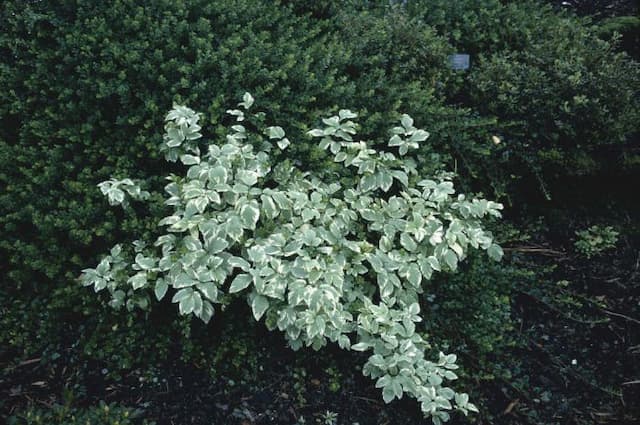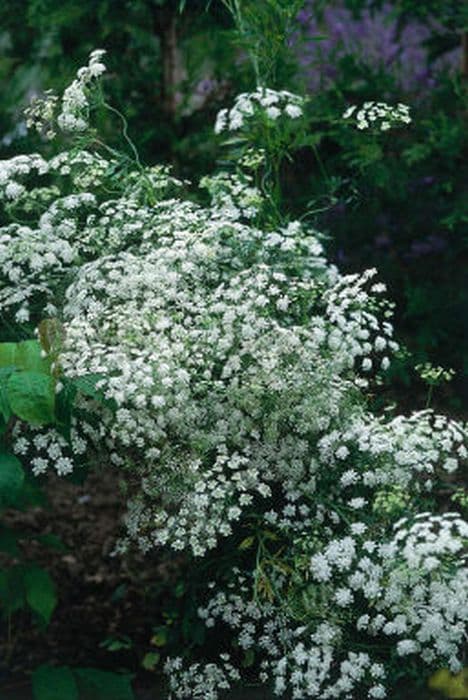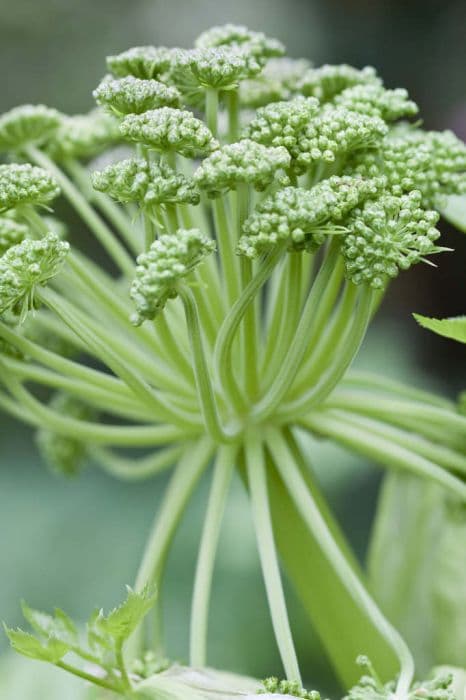Blue Lace Flower Trachymene coerulea

ABOUT
Trachymene coerulea, commonly known as blue lace flower, is an Australian native that is favored for its delicate beauty and ornamental value in gardens. The most striking feature of this plant is its intricate, lacy flower heads that bloom in a shade of vivid, sky blue. The flowers are small and round, grouped together in large, flat, umbrella-like clusters that resemble lacework. These blossoms create a soft, frothy appearance that can add a touch of whimsy to floral arrangements. The leaves of the blue lace flower are bright green and contribute to the plant's overall lush look. They are finely divided and fern-like, adding a textural contrast to the rounded form of the flower heads. Throughout its blooming period, the plant presents a palette of cool tones, with the blue of the flowers standing out against the green of the foliage. Overall, the appearance of the blue lace flower is characterized by its charming, delicate blossoms and fine, feathery leaves, which together create a light and airy presence in the garden setting. Its unique color and form have made it a popular choice for cottage gardens, as well as in cut flower arrangements where its beauty can be admired up close.
About this plant
 Names
NamesFamily
Apiaceae
Synonyms
Blue Lace Flower, Rottnest Island Daisy, Blue Rottnest Island Daisy
Common names
Didiscus coeruleus, Trachymene caerulea, Didiscus caeruleus.
 Toxicity
ToxicityTo humans
Blue lace flower (Trachymene coerulea) is not commonly known to be toxic to humans. There is limited information available about the plant's toxicity, so it is always advisable to handle unknown plants with caution and to avoid ingesting plants that are not known to be safe.
To pets
Blue lace flower (Trachymene coerulea) is not widely recognized as being toxic to pets. However, as with any plant, individual animals may have different sensitivities, and it is always best to prevent pets from ingesting plants that are not confirmed to be safe for consumption. If an animal does ingest part of the plant and exhibits symptoms of distress, it is important to consult with a veterinarian.
 Characteristics
CharacteristicsLife cycle
Perennials
Foliage type
Evergreen
Color of leaves
Green
Flower color
Blue
Height
2 feet [60 cm]
Spread
1 foot [30 cm]
Plant type
Herb
Hardiness zones
9
Native area
Australia
Benefits
 General Benefits
General Benefits- Attracts Wildlife: Trachymene coerulea, commonly known as Blue Lace Flower, attracts beneficial insects such as bees, butterflies, and other pollinators, fostering biodiversity.
- Aesthetic Appeal: The Blue Lace Flower is valued for its ornamental blue flowers which add a splash of color to gardens and floral arrangements.
- Drought Tolerance: Adapted to survive in dry conditions, Blue Lace Flower is an excellent choice for water-wise gardening, minimizing the need for frequent watering.
- Low Maintenance: It is relatively easy to care for, requiring minimal upkeep, which makes it ideal for both novice and seasoned gardeners.
- Fast Growing: The plant has a rapid growth cycle, allowing gardeners to enjoy its blooms relatively quickly after planting.
 Medical Properties
Medical PropertiesThis plant is not used for medical purposes.
 Air-purifying Qualities
Air-purifying QualitiesThis plant is not specifically known for air purifying qualities.
 Other Uses
Other Uses- Blue lace flower can be distilled to extract essential oils used in aromatherapy for creating a calming and serene atmosphere.
- Its sturdy stems and long vase life make it an excellent choice for dried floral arrangements, preserving the beauty of the blooms.
- The blooms of the blue lace flower can be used as natural confetti at celebrations such as weddings, providing a biodegradable option.
- The plant can be used in permaculture gardens as a companion plant due to its attractiveness to beneficial insects such as bees and butterflies.
- Dye can be extracted from the flowers of Trachymene coerulea for coloring fabrics and textiles in shades of blue to purple.
- Floral designers use the intricate patterns of the blue lace flower to add a touch of elegance and complexity to corsages and boutonnieres.
- Blue lace flower's seeds can be included in birdseed mixes as they provide a source of nutrition for many seed-eating birds.
- The plant is used in educational settings such as botanical studies to illustrate the structure and form of umbelliferous flowers.
- The flowers can be used to make a natural, gentle rinse for pets, leaving them with a pleasant, herbal scent.
- Photographers and artists often use blue lace flower as a subject or backdrop due to its delicate beauty and vibrant colors.
Interesting Facts
 Feng Shui
Feng ShuiThe Blue Lace Flower is not used in Feng Shui practice.
 Zodiac Sign Compitability
Zodiac Sign CompitabilityThe Blue Lace Flower is not used in astrology practice.
 Plant Symbolism
Plant Symbolism- Rarity: Trachymene coerulea, commonly known as the Blue Lace Flower, is not as common as some other plants, making it symbolic for uniqueness and the rarity of certain qualities or individuals.
- Delicate Beauty: The intricate lace-like flowers of the Blue Lace Flower symbolize delicate beauty and can represent appreciation for the more refined or elegant aspects of life.
- Charm: Its captivating look is often associated with charm and enchantment, suggesting the plant could be used to symbolize a charming personality or an enchanting occasion.
- Serenity: The soft blue color of the Blue Lace Flower can symbolize calmness and serenity, making it appropriate for occasions that call for peace and tranquility.
- Grace: The overall appearance and the way the stems and flowers seem to dance lightly in the wind may symbolize grace and poise.
 Water
WaterBlue lace flower requires moderate watering, implying that you should water it when the top inch of soil feels dry, typically about once a week. The method of watering should assure even soil moisture, and it can be achieved by using a watering can or hose with a gentle spray setting. For indoor plants, it is advisable to water with approximately 16-24 ounces of water, depending on pot size and environment conditions. During the active growth period in spring and summer, the plant may need more frequent watering. In contrast, in the dormant winter months, water less frequently, allowing the soil to dry out more between waterings.
 Light
LightBlue lace flower thrives best in full sun to partial shade conditions. The ideal spot for this plant is a location where it receives at least 6 hours of sunlight each day, though it should be protected from the harsh midday sun if in a particularly hot climate. A spot that provides morning sunlight and dappled afternoon shade is ideal for the blue lace flower to flourish.
 Temperature
TemperatureBlue lace flower prefers temperate conditions and can endure a temperature range from around 50°F to 90°F. The ideal temperature for promoting growth is between 60°F and 75°F. It should be protected from frost, as temperatures below 32°F can cause damage to the plant.
 Pruning
PruningPruning blue lace flower is done to maintain its shape, encourage bushier growth, and remove spent flowers to promote further blooming. The best time for pruning is after the main flowering peak has passed, which is typically in late summer. Light pruning every few weeks during the blooming season can help to keep the plant looking tidy and may encourage additional blooms.
 Cleaning
CleaningAs needed
 Soil
SoilBlue lace flower thrives in well-draining soil with moderately fertility. The best mix could be equal parts garden soil, compost, and perlite or sand. A slightly acidic to neutral pH of 6.0 to 7.0 is ideal for this plant.
 Repotting
RepottingBlue lace flower does not often require repotting; it can be repotted every 2 to 3 years or when it outgrows its current pot.
 Humidity & Misting
Humidity & MistingBlue lace flower prefers moderate humidity levels but is quite adaptable to different humidity conditions found in average home environments.
 Suitable locations
Suitable locationsIndoor
Place blue lace flower in bright, indirect light indoors.
Outdoor
Plant blue lace flower in a sunny location with some afternoon shade.
Hardiness zone
9-11 USDA
 Life cycle
Life cycleTrachymene coerulea, commonly known as Blue Lace Flower, begins its life cycle as a seed, which germinates in moist soil conditions with adequate sunlight and warmth. Upon germination, the seedling emerges, developing its root system and initial leaves, a phase called vegetative growth, which is critical for establishing the plant. As it matures, it enters the flowering stage, producing clusters of distinctive blue to violet flowers that are attractive to pollinators. After successful pollination, typically by insects such as bees, the flowers develop into fruit which contain seeds, marking the reproductive stage of the life cycle. Once the seeds are mature, they are dispersed by various means such as wind or animal movement, enabling the cycle to begin anew if they land in conditions conducive to germination. The plant has an annual life cycle, meaning it completes this entire process within one growing season before dying, relying on seed production for propagation.
 Propogation
PropogationPropogation time
Spring-Early Summer
The most common method of propagating Trachymene coerulea, commonly known as Blue Lace Flower, is through seed. The best time to sow the seeds is in early spring after the last frost when the soil has warmed. Typically, the seeds are scattered directly onto well-drained soil and lightly covered with soil to a depth roughly equal to the size of the seed. A general guideline is to plant the seeds at a depth of about 0.25 inches (0.64 centimeters). The area should be kept moist, especially during the period of germination, which is usually within two to three weeks. Once the seedlings are sufficiently grown, they may be thinned out to allow the strongest plants room to mature.









